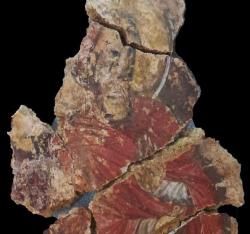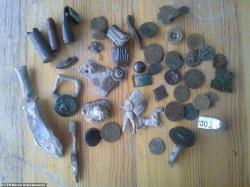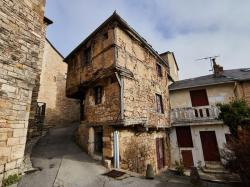INSTITUT SUPERIEUR D'ANTHROPOLOGIE
INSTITUTE OF ANTHROPOLOGY
ONLINE COURSES / COURS A DISTANCE
FALL TERM : OCTOBER 2018
REGISTER NOW
ARABIE SAOUDITE – 
 Ghilan - Excavations at the Ghilan archaeological site in the Riyadh region have revealed glazed and unglazed pottery fragments dating back to the early Islamic era. The work has revealed that Ghilan palace was built at the foot of a mountain overlooking the valley of Sudair, 684 meters above sea level. The work will continue for several seasons,
Ghilan - Excavations at the Ghilan archaeological site in the Riyadh region have revealed glazed and unglazed pottery fragments dating back to the early Islamic era. The work has revealed that Ghilan palace was built at the foot of a mountain overlooking the valley of Sudair, 684 meters above sea level. The work will continue for several seasons,
http://www.arabnews.com/node/1385866/saudi-arabia
CAMBODGE –  Koh Ker - Koh Ker was part of the Khmer kingdom during the Angkor period in what is now Cambodia. For a mere two decades in the tenth century CE, the city served as royal capital, and it has long been proposed that after the royal seat moved back to Angkor, the city and its surroundings were abandoned. In this study, Hall and colleagues tested this theory by analyzing charcoal and pollen remains in sediment cores spanning several centuries in three Koh Ker localities, including the moat of the main central temple. From these data, they inferred a long history of fluctuations in fire regimes and vegetation which are highly indicative of patterns of human occupation and land use over time. The newly-painted picture is of a region that was occupied well before the Angkor period, at least as far back as the late 7th century CE, and continuing seven centuries or more after the royal seat’s departure. The authors suggest that the mobility of royal houses may have had less of an impact on regional populations in the Khmer kingdom than previously thought. This study also highlights the utility of palaeoecological tools to reconstruct the occupational history of ancient urban settlements. Hall adds: “When the environmental record is analyzed, it becomes clear that Koh Ker was much more than a temporary 10th century capital of the Khmer kingdom. The settlement history of the site is extensive and complex, beginning in the pre-Angkor period and lasting for centuries beyond the decline of Angkor.”
Koh Ker - Koh Ker was part of the Khmer kingdom during the Angkor period in what is now Cambodia. For a mere two decades in the tenth century CE, the city served as royal capital, and it has long been proposed that after the royal seat moved back to Angkor, the city and its surroundings were abandoned. In this study, Hall and colleagues tested this theory by analyzing charcoal and pollen remains in sediment cores spanning several centuries in three Koh Ker localities, including the moat of the main central temple. From these data, they inferred a long history of fluctuations in fire regimes and vegetation which are highly indicative of patterns of human occupation and land use over time. The newly-painted picture is of a region that was occupied well before the Angkor period, at least as far back as the late 7th century CE, and continuing seven centuries or more after the royal seat’s departure. The authors suggest that the mobility of royal houses may have had less of an impact on regional populations in the Khmer kingdom than previously thought. This study also highlights the utility of palaeoecological tools to reconstruct the occupational history of ancient urban settlements. Hall adds: “When the environmental record is analyzed, it becomes clear that Koh Ker was much more than a temporary 10th century capital of the Khmer kingdom. The settlement history of the site is extensive and complex, beginning in the pre-Angkor period and lasting for centuries beyond the decline of Angkor.”
https://www.heritagedaily.com/2018/10/city-of-koh-ker-was-occupied-for-centuries-longer-than-previously-thought/121873
BULGARIE –  Tarnovgrad - A thirteenth-century Christian church and cemetery have been uncovered in the Trapesitsa Fortress in Tarnovgrad, the medieval capital of the Second Bulgarian Empire. The church is the twenty-third to have been discovered in the fortress. It measured about 12 feet wide and 30 feet long, and was affixed to the inside of the fortress wall, next to a fortress tower or bastion that is still under excavation. Fragments of murals depicting three human figures wearing halos have been recovered, including one of Jesus Christ the Pantocrator—a specific image in Christian iconography. “The frescoes are very beautiful,” said Konstantin Totev of the Veliko Tarnovo Office of the National Institute and Museum. “In terms of quality and artistic value, they surpass those found in churches No. 13 and 2, which have been deemed the most beautiful in the Trapesitsa Fortress so far.” Totev thinks the building may have served as a parish church for merchants and craftsmen who lived nearby.
Tarnovgrad - A thirteenth-century Christian church and cemetery have been uncovered in the Trapesitsa Fortress in Tarnovgrad, the medieval capital of the Second Bulgarian Empire. The church is the twenty-third to have been discovered in the fortress. It measured about 12 feet wide and 30 feet long, and was affixed to the inside of the fortress wall, next to a fortress tower or bastion that is still under excavation. Fragments of murals depicting three human figures wearing halos have been recovered, including one of Jesus Christ the Pantocrator—a specific image in Christian iconography. “The frescoes are very beautiful,” said Konstantin Totev of the Veliko Tarnovo Office of the National Institute and Museum. “In terms of quality and artistic value, they surpass those found in churches No. 13 and 2, which have been deemed the most beautiful in the Trapesitsa Fortress so far.” Totev thinks the building may have served as a parish church for merchants and craftsmen who lived nearby.
http://archaeologyinbulgaria.com/2018/10/02/intriguing-13th-century-church-with-surviving-frescos-of-jesus-christ-discovered-in-trapesitsa-fortress-in-medieval-bulgarian-capital-veliko-tarnovo/
USA –  St. Augustine - A team led by Kathleen Deagan of the University of Florida and Timothy Johnson of Flagler College is investigating a building foundation first uncovered in the 1950s at St. Augustine’s Mission Nombre de Dios by Father Charles Spellman, a Christian priest and archaeologist who recorded his discovery and mapped it, but did not share it with others. He thought the building could be a shrine to Our Lady of La Leche, built in 1677 by the Spanish. “It got covered up and everyone forgot about it,” Deagan explained. Her team rediscovered the foundation in 2011, and Spellman’s records were found in a church archive in 2009. Deagan’s team will now try to determine whether the building served as a church, chapel, or convent, and whether it may have been a pilgrimage destination. The site could also help scholars understand how the first Europeans in St. Augustine interacted with each other and with the region’s indigenous population.
St. Augustine - A team led by Kathleen Deagan of the University of Florida and Timothy Johnson of Flagler College is investigating a building foundation first uncovered in the 1950s at St. Augustine’s Mission Nombre de Dios by Father Charles Spellman, a Christian priest and archaeologist who recorded his discovery and mapped it, but did not share it with others. He thought the building could be a shrine to Our Lady of La Leche, built in 1677 by the Spanish. “It got covered up and everyone forgot about it,” Deagan explained. Her team rediscovered the foundation in 2011, and Spellman’s records were found in a church archive in 2009. Deagan’s team will now try to determine whether the building served as a church, chapel, or convent, and whether it may have been a pilgrimage destination. The site could also help scholars understand how the first Europeans in St. Augustine interacted with each other and with the region’s indigenous population.
http://www.staugustine.com/news/20181009/mysterious-17th-century-building-being-uncovered-at-mission
POLOGNE – 
 Stare Czarnowo - Silver coins which are believed to be more than 1,000 years old are among a slew of other artefacts and trinkets that were unearthed by farmers. The finds were made in the village of Stare Czarnow and are the result of a project that began in 2015, launched after a number of artefacts were found in Old Czarnow in the West Pomeranian region. Researcher and archaeologist Marcin Dziewianowski, who is conducting the excavations, said: 'The farmers scattered the treasure in the field for decades. 'We found parts of it in an area measuring 60 metres (196 feet) by 15 metres (49 feet). 'We started digging after locals began finding old coins in the field and we became interested in the place'.According to experts, the objects could be the treasure of a jeweller or a smith from more than 1,000 years ago. Mr Dziewanowski added: 'We managed to find whole Arabian dirham coins and other coins including a very rare one attributed to the Volga-Kama Bulghar tribe. 'A great part of the coins have been partially melted which outlines the use of the treasure. Also fragments of jewellery, earrings, beads and silver bars were found.' Many of the objects are believed to date back to the late 10th century.
Stare Czarnowo - Silver coins which are believed to be more than 1,000 years old are among a slew of other artefacts and trinkets that were unearthed by farmers. The finds were made in the village of Stare Czarnow and are the result of a project that began in 2015, launched after a number of artefacts were found in Old Czarnow in the West Pomeranian region. Researcher and archaeologist Marcin Dziewianowski, who is conducting the excavations, said: 'The farmers scattered the treasure in the field for decades. 'We found parts of it in an area measuring 60 metres (196 feet) by 15 metres (49 feet). 'We started digging after locals began finding old coins in the field and we became interested in the place'.According to experts, the objects could be the treasure of a jeweller or a smith from more than 1,000 years ago. Mr Dziewanowski added: 'We managed to find whole Arabian dirham coins and other coins including a very rare one attributed to the Volga-Kama Bulghar tribe. 'A great part of the coins have been partially melted which outlines the use of the treasure. Also fragments of jewellery, earrings, beads and silver bars were found.' Many of the objects are believed to date back to the late 10th century.
https://www.dailymail.co.uk/sciencetech/article-6260393/More-300-silver-coins-thought-1-000-years-old-unearthed-Poland.html
FRANCE –  Sévérac-le-Château - C’est une très vieille dame à l’allure particulièrement fragile mais toujours debout malgré les siècles... Baptisée la «maison de Jeanne» par les intimes, du prénom de sa dernière occupante, cette bâtisse de Sévérac-le-Château (Aveyron) est réputée être la plus vieille maison du Rouergue. On estime généralement qu’elle a été construite au 12e ou au 13e siècle. Les travaux de restauration ont déjà permis de découvrir la bâtisse médiévale de deux étages, puis d’en démonter les murs. Une mise à nu qui doit permettre une datation précise de la construction. C’est le CEDRE (Centre d’Étude Dendrochronologie et Recherche en Écologie), basé à Besançon, qui se charge de cette opération en effectuant une vingtaine de prélèvements sur les boiseries. En s’appuyant sur ces relevés et en distinguant les réfections successives du bâtiment, les scientifiques pourront distinguer et comptabiliser chaque anneau de croissance du bois pour parvenir à une date précise à la saison près. Les résultats sont attendus d’ici un mois. Le spécialiste de dendrochronologie venu sur place étudier les poutres de chêne de la «maison de Jeanne» a admis devant le journal local, n’avoir jamais daté une maison remontant plus loin que le 15e siècle. Un record personnel qui devrait être battu selon toute vraisemblance. Verdict dans quelques jours.
Sévérac-le-Château - C’est une très vieille dame à l’allure particulièrement fragile mais toujours debout malgré les siècles... Baptisée la «maison de Jeanne» par les intimes, du prénom de sa dernière occupante, cette bâtisse de Sévérac-le-Château (Aveyron) est réputée être la plus vieille maison du Rouergue. On estime généralement qu’elle a été construite au 12e ou au 13e siècle. Les travaux de restauration ont déjà permis de découvrir la bâtisse médiévale de deux étages, puis d’en démonter les murs. Une mise à nu qui doit permettre une datation précise de la construction. C’est le CEDRE (Centre d’Étude Dendrochronologie et Recherche en Écologie), basé à Besançon, qui se charge de cette opération en effectuant une vingtaine de prélèvements sur les boiseries. En s’appuyant sur ces relevés et en distinguant les réfections successives du bâtiment, les scientifiques pourront distinguer et comptabiliser chaque anneau de croissance du bois pour parvenir à une date précise à la saison près. Les résultats sont attendus d’ici un mois. Le spécialiste de dendrochronologie venu sur place étudier les poutres de chêne de la «maison de Jeanne» a admis devant le journal local, n’avoir jamais daté une maison remontant plus loin que le 15e siècle. Un record personnel qui devrait être battu selon toute vraisemblance. Verdict dans quelques jours.
https://immobilier.lefigaro.fr/article/on-connaitra-bientot-l-age-exact-de-la-plus-vieille-maison-d-aveyron_5ec1ebe4-cc99-11e8-913b-46be04476de0/